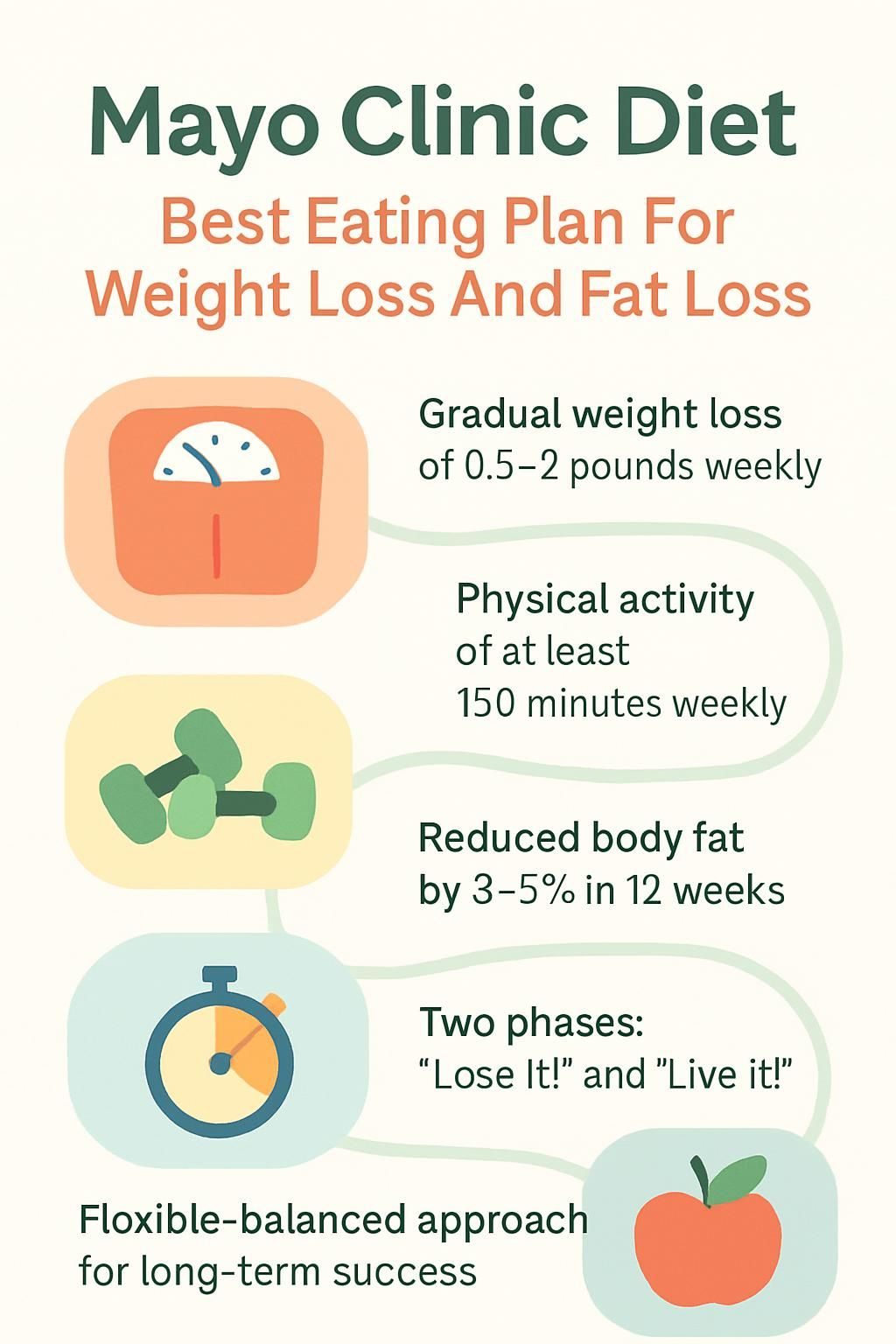Mayo Clinic Diet: Best Eating Plan For Weight Loss And Fat Loss
Our Nutrition Assistant AI Suite will transform your body. You will lose fat, get toned, and build muscle. Gain confidence and optimal health.
If you have tried different diets yet still struggle to lose weight or body fat, you are not alone. Many people want an eating plan that works in real life and supports long-term weight loss. The Mayo Clinic Diet focuses on healthy eating habits, portion control, and safe physical activity instead of quick fixes. This guide explains how the Mayo Clinic Diet helps you reach a healthy weight, improve your health, and keep your results.
Learn why this diet plan can be a practical path to lasting change.
Key Takeaways
- The Mayo Clinic Diet supports gradual weight loss of about 0.5 to 2 pounds per week through a calorie deficit, smart portions, and regular movement of at least 150 minutes weekly.
- You center meals on fruits, vegetables, whole grains, lean proteins, and healthy fats like olive oil. You limit added sugars and highly processed foods for steady results.
- The program has two phases, “Lose It!” for a jumpstart and “Live It!” for long-term maintenance. You can use books or online tools from Mayo Clinic for support.
- Following this approach has been linked to lower body fat percentage, better blood sugar control, improved heart health, and reduced risk of several diseases.
- Compared with restrictive plans like Keto or strict intermittent fasting, the Mayo Clinic Diet offers a flexible, balanced strategy that fits daily life.

What is the Mayo Clinic Diet?

The Mayo Clinic Diet is a structured diet plan built by medical and nutrition experts to help you lose weight safely and keep it off. The plan uses research-tested steps to improve eating habits and support long-term weight management.
What is the Mayo Clinic Diet?
Mayo Clinic, a respected health system in Arizona, Florida, and Minnesota, created this program to guide healthy weight loss and fat loss. You eat more fruits and vegetables, whole grains, lean proteins, and healthy fats such as olive oil and avocados.
This approach supports long-term results instead of quick, short-term changes. You also get clear goals and tools that promote better heart health and daily energy.
I tried this plan after reading success stories on the Mayo Clinic site. Shifting to more plant-forward meals made my calorie deficit easier to maintain without feeling deprived.
People at many life stages can follow this balanced style of eating if they want sustainable, evidence-based results.
What are the main principles of the Mayo Clinic Diet?
Now that you know the basics, here are the key principles. You focus on natural or minimally processed foods that supply fiber, protein, vitamins, and minerals. Lean proteins, vegetables, fruits, whole grains, low-fat dairy, and nuts become everyday staples. You limit added sugars, refined grains, and unhealthy fats to support a calorie deficit.
Weight loss aims for 0.5 to 2 pounds per week, supported by portion control and filling foods that are low in calories but high in fiber and protein. Physical activity increases while sedentary time, like long hours of sitting, goes down. The plan avoids extreme rules often seen in fad diet trends.
During a busy season at work, I kept meals simple and colorful. That made planning easier and kept me from reaching for junk food during stressful moments.
Fill half your plate with fruits and vegetables at every meal. It is a simple rule that works.
The goal is to build habits that last, not just fast results that fade.
How the Mayo Clinic Diet Works
This diet uses practical steps to help you lose weight and maintain it. The method focuses on steady changes you can live with day after day.
How does the Mayo Clinic Diet promote healthy eating habits?
You choose whole foods instead of packaged or highly processed options. The diet emphasizes plant-based choices like fruits and vegetables, which provide dietary fiber and essential nutrients that support health.
Lean proteins include fish, poultry, legumes, and eggs. Healthy fats come from olive oil, avocados, and nuts rather than saturated or trans fats. Setting daily goals keeps motivation high while your new habits take hold.
Balanced meals give your body what it needs without too many calories. Portion control keeps intake in check. When I followed this plan, I cut out most sugary snacks because I felt full longer with more vegetables and protein at meals.
Online resources and local groups can help you continue making smart choices. This support improves heart health, blood sugar control, and long-term weight maintenance.
How does calorie deficit and portion control aid weight loss?
A calorie deficit means you eat fewer calories than you burn. Cutting about 500 to 1,000 calories per day usually leads to a loss of 0.5 to 2 pounds per week, which is considered safe.
Meals built around fruits, vegetables, lean protein, whole grains, and healthy fats help you stay satisfied while keeping calories reasonable. Avoid very low-calorie diets under 800 calories unless a clinician is supervising, since they can affect heart health and metabolism.
Portion control prevents overeating at meals and snacks. Sample meal guides from the Mayo Clinic Diet make measuring easier, for example one cup of bran flakes with a half cup of strawberries, a few walnuts, and nonfat milk for breakfast.
Tracking intake increases awareness. I used a food diary for several weeks and saw change quickly because I could spot patterns and adjust.
“Portion control was the single biggest factor that helped me curb mindless snacking,” says Sarah R., who started the Mayo Clinic Diet after her doctor warned about type 2 diabetes risk.
Regular physical activity works with these habits so progress is more consistent.
Why is regular physical activity important in this diet?
Exercise helps preserve muscle while you lose fat. That matters because muscle helps keep your metabolism steady during a calorie deficit.
You are encouraged to aim for at least 150 minutes per week of moderate activity such as brisk walking or swimming. Staying active also helps prevent weight regain after you reach your goal.
Start small and choose activities you enjoy. I found that a daily walk improved my mood and energy, and it helped me maintain my results longer.
Movement supports management of obesity, heart disease, diabetes, and high blood pressure. It also lowers blood pressure and cholesterol, which supports heart health. Small bouts of movement during the day add up and provide benefits that food alone cannot.
Key Features of the Mayo Clinic Diet
This plan focuses on practical choices that lead to steady progress. It borrows smart ideas from eating patterns like the Mediterranean, DASH, and MIND diets.
Importance of fruits, vegetables, and whole grains
Fruits, vegetables, and whole grains form the base of the Mayo Clinic Diet. Aim to fill half your plate with produce at each meal. This guideline mirrors successful patterns like the Mediterranean diet and the DASH diet.
These foods are rich in fiber, vitamins, potassium, and antioxidants. A plant-forward plate can lower risk for heart disease, stroke, cancer, and type 2 diabetes while supporting weight loss.
Whole grains such as brown rice, oats, quinoa, and whole wheat bread provide steady energy. They slow digestion, which helps manage blood sugar. People who eat whole grains often have healthier body weight compared with those who rely on refined carbs^1^.
Adding legumes like beans and lentils boosts protein and fiber. These choices help limit added sugars and unhealthy fats while keeping you full longer.
Next, see how reducing added sugars and unhealthy fats protects your progress.
How to limit added sugars and unhealthy fats
Start with simple swaps. Replace soda with water or unsweetened tea. Read labels on snacks and sauces to catch hidden sugars. A reasonable target for many adults is less than 25 grams of added sugar per day.
Pick oils such as olive or canola instead of butter. Choose snacks like almonds or Greek yogurt that are naturally low in added sugar. Limit trans fats by avoiding packaged baked goods, fried fast food, and refined carbohydrates that spike blood sugar.
This mix of choices supports lower blood pressure and better heart health according to guidance from major health organizations.
How does the diet encourage healthy lifestyle changes?
You build new habits with small steps. A food and activity journal increases awareness of hunger cues and patterns. Research shows that record keeping supports long-term weight maintenance.
The plan does not require special supplements or meal replacements. You eat regular foods from all groups, including lean proteins, whole grains, fruits like apples, and vegetables such as spinach.
Support from online forums or in-person groups can help during social events or when cravings hit. The structure is flexible, which helps if you are managing high blood pressure, lowering heart risks, or addressing dietary limits during pregnancy.
Rather than chasing rapid fat loss that fades, you practice daily improvements that carry from “Lose It!” into “Live It!”.
Phases of the Mayo Clinic Diet
The diet has two clear phases that help you lose weight, then maintain your results.
What is Phase 1: “Lose It!” and how does it jumpstart weight loss?
Phase 1, called “Lose It!”, sets the tone with quick but safe habit changes. You swap processed and sugary foods for more fruits, vegetables, and whole grains.
This phase lasts about two weeks and often leads to visible progress. Many people lose 0.5 to 2 pounds per week, which supports motivation.
You track portions and build a routine around regular activity like brisk walking or cycling. Early wins help you commit to the next stage that supports long-term change.
What is Phase 2: “Live It!” and how does it support long-term maintenance?
In “Live It!”, you shift to maintenance. The focus is on flexible, sustainable habits that match your life.
Meal planning becomes easier. You track your food and activity to reinforce routines. You still emphasize fruits, vegetables, whole grains, lean proteins like poultry or legumes, nuts such as almonds, and healthy fats like olive oil or avocado.
These choices help reduce body fat while supporting heart health and stable blood sugar. Regular exercise remains a key pillar for lasting success.
Benefits of the Mayo Clinic Diet
This diet offers health benefits while teaching daily habits that help you maintain your progress.
How does this diet support sustainable weight loss?
You focus on slow, steady progress. The plan targets about 0.5 to 2 pounds per week, using filling foods that keep hunger in check.
Studies show gradual weight loss is easier to maintain and gentler on your body. You avoid feeling deprived because the plan includes fruits, vegetables, whole grains, lean proteins, and dairy options.
You build healthy routines instead of chasing fads. Pairing regular movement with balanced meals leads to greater weight loss after 1 year compared with low fat meals alone.
Last summer I planned simple meals and tracked progress weekly. That kept me motivated without feeling bored or hungry.
Portion control creates a calorie deficit that produces real results while keeping meals practical for busy days.
How does it reduce body fat percentage?
A focus on whole foods and fiber helps you feel full on fewer calories. Fruits, vegetables, beans, and whole grains support a calorie deficit, which reduces excess body fat.
Lean proteins like chicken or fish and healthy fats from nuts or olive oil help preserve muscle. Regular activity, even brisk walking for 30 minutes daily, increases calorie burn. Tracking your meals and workouts allows you to fine-tune portions and effort.
I saw the best fat loss when I centered meals on fiber-rich produce and kept workouts steady, rather than trying extreme low carb trends.
Research shows that structured eating plans combined with movement lower both body weight and body fat percentages^1^. For instance, WW International reported average body fat reductions of 3 to 5 percent over twelve weeks with planned eating and regular activity.
How does it improve heart health?
A produce-rich plate supports heart health. Fiber from fruits, vegetables, and whole grains helps lower LDL cholesterol, which can reduce heart disease risk.
Choosing olive oil and nuts in place of saturated fats supports healthier blood vessels. Limiting processed foods high in sodium or added sugars helps with blood pressure control.
Routine physical activity improves insulin sensitivity and reduces inflammation, both linked with better heart outcomes. The plan uses strategies similar to Mediterranean and DASH diets, which have strong evidence for heart benefits.
How does it help manage blood sugar levels?
You reduce added sugars and lean on high-fiber foods such as whole grains, fruits, and vegetables. Fiber slows the rise of blood sugar after meals.
Limiting refined carbs like white bread and sugary snacks helps control glucose spikes. Including lean proteins and healthy fats, such as fish and avocado, also steadies blood sugar.
Gradual weight loss improves blood glucose control over time. Many people find energy and mood more stable once these habits become routine.
What are the overall well-being benefits?
Eating this way can lower risk for diabetes, stroke, coronary artery disease, colorectal cancer, and breast cancer. Diets built on minimally processed foods are linked with lower rates of depression and dementia in several studies.
Healthy routines can improve daily energy and motivation. Ongoing weight management may reduce risks for gallbladder and kidney problems linked to obesity.
Regular exercise, which the diet encourages, supports brain health. Many people notice steadier moods as blood sugar swings become less common.
Comparison with Other Popular Diets
Comparing plans helps you choose a diet strategy that matches your goals and lifestyle.
How does the Mayo Clinic Diet compare to the Mediterranean Diet?
Both plans focus on fruits, vegetables, legumes, nuts, and whole grains. Each approach favors natural foods over processed items to improve health and support weight loss.
The Mediterranean diet relies on olive oil as the main fat and limits red meat. Both plans include moderate amounts of yogurt, cheese, poultry, and fish.
Research links these eating styles with lower risk for heart disease, diabetes, depression, some cancers, and neurodegenerative conditions like dementia^1^,^2^. Following a Mediterranean pattern has also been tied to lower stroke risk and longer life.
The Mayo Clinic Diet stands out for its two phases, “Lose It!” then “Live It!”, which many find easier to follow. I found the phased structure practical while still enjoying the variety both styles allow.
Next is how this plan compares with Keto for people who want fast but safe progress.
1) “Adherence to a Mediterranean diet leads to weight loss,” Nutrition Reviews
2) Harvard School of Public Health: “Mediterranean Diet
How does it compare to the Keto Diet?
The Mayo Clinic Diet is balanced. You eat fruits, vegetables, whole grains, and lean proteins that supply fiber, vitamins, and minerals your body needs.
The Keto Diet restricts carbohydrates and gets most calories from fat. The goal is ketosis, a state where your body burns fat for fuel instead of carbs.
Keto may lead to fast weight loss, but it can be hard to maintain and may lack key nutrients often found in whole grains and legumes. Early blood sugar improvements may occur, yet long-term safety data are still limited. The Mayo Clinic Diet promotes steady loss and habits you can keep for life.
Those who want flexibility, better heart health, less salt, or more plant-forward meals may find the Mayo Clinic plan a better fit than strict low carb options.
How does it compare to Intermittent Fasting?
Intermittent fasting rotates between eating and fasting windows, such as 16:8 or 5:2. It may lower blood sugar and reduce inflammation for some people, but it can be challenging at social events.
The Mayo Clinic Diet keeps regular meal patterns and focuses on building habits like eating more produce, whole grains, legumes, and nuts while limiting added sugars and unhealthy fats. Both methods create a calorie deficit. The Mayo approach offers daily flexibility that many people prefer.
Tips for Success with the Mayo Clinic Diet
Success grows from simple routines that you repeat. These steps help you plan meals, manage stress, and stay motivated while you pursue better health.
How to plan and prepare meals effectively?
Planning meals makes healthy eating easier and supports your weight loss goals. Focus on balance, variety, and speed in the kitchen.
- List healthy foods you enjoy, like fruits, vegetables, lean proteins, nuts, and whole grains. This makes a plan you can follow.
- Use the Healthy Eating Plate as a guide. Aim for half vegetables, one quarter whole grains, and one quarter lean protein.
- Build meals around proteins such as grilled chicken or legumes. Add colorful produce each week for taste and nutrients.
- Keep meals simple, for example salmon with spinach or a veggie-loaded turkey sandwich on whole grain bread.
- Limit processed foods when shopping. Choose produce, plain nuts, and olive oil, and skip high sugar snacks.
- Pick smart snacks like Greek yogurt, a banana with peanut butter, string cheese with an apple, or unsalted nuts.
- Track what you eat. A short record highlights patterns that help or slow your progress.
- Prep ahead for busy days, such as batch-cooking grains or chopping extra vegetables.
- Adjust portion sizes using Mayo Clinic guidelines to support a calorie deficit and fat loss.
With a plan in place, staying active will reinforce your results.
How to stay active and consistent on the diet?
Daily movement supports weight loss and better health. Make activity simple and consistent.
- Set a daily goal, such as 30 minutes of moderate exercise, to build momentum.
- Work activity into your day. Take walking breaks, stand more, and choose stairs.
- Pick activities you enjoy, like swimming, dancing, or biking, to stick with it.
- Track both activity and food with an app or journal. Seeing progress maintains motivation.
- Increase effort over time. Start with walks, then add intervals or strength training.
- Join a support group or online community for accountability and ideas.
- Combine diet and exercise. The pair works better for fat loss than diet alone.
- Use reminders or keep workout gear visible to prompt action.
Regular movement improves weight, mood, and focus. It makes healthy eating pay off faster.
How to track progress and stay motivated?
Tracking keeps you honest and shows what works. Motivation grows when you see proof.
- Write down what you eat and your activity each day. Keep it simple but detailed.
- Set small weekly goals, for example losing 0.5 to 2 pounds or swapping soup for a high-calorie snack two days this week.
- Watch weight trends over time with a chart or app. Do not worry about day-to-day changes.
- Use support, such as online groups or in-person meetings, for ideas and encouragement.
- Celebrate wins with non-food rewards, such as new gear or a relaxing activity.
- Adjust goals if progress stalls. Review portions and try a small bump in activity.
- Use visual tools like calendars or stickers to track streaks and keep habits visible.
- Get practical tips from trusted sources, including Mayo Clinic emails with meal ideas.
- Share your ups and downs with a friend. Talking through hard days helps you stay on track.
Writing down everything I ate, including several simple soup recipes, helped me stay honest and made progress easier to manage.
Common Challenges and How to Overcome Them
Every plan meets obstacles. These steps can help you stay on course.
How to manage cravings while on the diet?
Cravings are normal. Plan for them so they do not derail your efforts.
- Choose snacks like nuts, Greek yogurt, or fruit with nut butter to satisfy hunger.
- Focus on high-fiber foods such as whole grains, beans, and vegetables to stay full.
- Plan meals and snacks to avoid long gaps that trigger overeating.
- Keep tempting processed foods out of the house to reduce triggers.
- Drink water often. Thirst can feel like hunger.
- Practice mindful eating. Slow down and stop when satisfied, not stuffed.
- Swap cravings for better choices, like air-popped popcorn instead of chips.
- Build routines around your toughest times of day, such as mid-afternoon.
- Track patterns in a journal or app to spot and address triggers early.
These steps align with principles taught in the Mayo Clinic Diet and help you manage cravings with confidence.
How to stay committed during social events?
Social events bring food pressure. A simple plan lets you enjoy yourself without losing momentum.
- Bring a healthy dish or snack to share, such as mixed nuts or fresh fruit.
- Use the plate method for portion control, even if you sample a treat.
- Choose the healthiest options available, or politely decline offers that do not fit your plan.
- Tell friends or family your goals ahead of time to build support.
- Focus on conversations and activities away from the food table.
- Eat a healthy meal or snack before you go so you arrive satisfied.
- Set boundaries and allow small treats without guilt. Flexible rules prevent rebound eating.
- Lean on your support network if you struggle in public settings.
How to handle weight loss plateaus?
Plateaus are common. Your body is adjusting. A few tweaks can restart progress.
- Recheck portions and total calories. Small increases can slow fat loss over time.
- Shift meal makeup toward lean proteins and fiber-rich foods to boost fullness.
- Add variety or intensity to workouts, for example intervals or two days of strength training per week.
- Track food, workouts, mood, and sleep to find hidden patterns or extra calories.
- Stay patient. Plateaus are normal and usually pass with consistent habits.
- Ask a registered dietitian or clinician for tailored advice if progress stalls.
- Count non-scale wins, like smaller waist, better blood sugar, or lower blood pressure.
- Review goals each month and make small adjustments to keep moving forward.
Most people see progress return within several weeks with these adjustments.
Who Should Try the Mayo Clinic Diet?
This plan suits many people who want a clear structure and lasting results.
Who is the Mayo Clinic Diet best suited for?
If your goal is steady weight loss, the Mayo Clinic Diet may fit well. It targets 0.5 to 2 pounds per week using everyday foods instead of special products.
The program is flexible enough to match personal preferences, culture, and dietary needs. People who have tried many fad diets often find this plan more realistic and supportive.
Online tools and in-person support are available if you want guidance along the way.
Who can benefit from this diet based on health goals?
Adults with excess weight or obesity often choose this plan because it is safe and sustainable. Those seeking better heart health benefit from meals rich in produce and whole grains. If you want to prevent or manage type 2 diabetes, the plan’s focus on fiber and balanced meals helps stabilize blood sugar.
Many people also report clearer thinking and better mood. If you have specific medical needs, ask your clinician how to adapt the plan to your situation.
Knowing which foods to choose will help you start strong.
What Foods to Eat on the Mayo Clinic Diet
You have many nutrient-rich options that help you feel full and support fat loss.
Which lean proteins and legumes are recommended?
Choosing lean proteins and legumes supports weight loss while preserving muscle.
- Pick chicken breast, turkey breast, and other skinless poultry for low-fat, high-protein meals.
- Eat fish such as salmon, tuna, or mackerel at least twice per week. These provide heart-healthy fats.
- Add eggs to meals or snacks for a convenient, nutrient-dense choice.
- Use Greek yogurt or string cheese for quick, high-protein snacks.
- Include beans such as black beans, kidney beans, and chickpeas for protein and fiber.
- Stir lentils into soups, salads, or sides for added plant protein.
- Build a turkey sandwich on whole wheat bread for protein plus whole grains.
- Try split peas or navy beans in stews to add variety without extra fat.
- Sprinkle a small amount of almonds or walnuts on salads for healthy fats and some protein.
Next, stock up on colorful produce to round out your plate.
What fresh fruits and vegetables should be included?
Fresh produce provides fiber, vitamins, and minerals that support weight loss and energy.
- Choose strawberries, apples, bananas, blueberries, and raspberries for natural sweetness and fullness.
- Add leafy greens like spinach, kale, and romaine to salads or wraps for nutrients with few calories.
- Use root vegetables such as carrots, beets, turnips, and rutabagas for hearty sides.
- Fill half your plate with vegetables at meals to follow Mayo Clinic guidance.
- Pick fresh or minimally processed produce instead of sugary canned options.
- Use tomatoes, cucumbers, bell peppers, onions, broccoli, and cauliflower for variety and antioxidants.
- Include citrus fruits like oranges or grapefruit for vitamin C and flavor.
- We often mix berries into oatmeal on busy mornings. It adds taste without added sugar.
These choices help control calories while keeping meals satisfying.
Which whole grains and nuts fit the diet?
Whole grains and nuts provide fiber, healthy fats, and steady energy.
- Whole wheat bread and pasta support fullness and may help lower cholesterol.
- Oats contain beta-glucan, a fiber that supports heart health and blood sugar control.
- Brown rice has more nutrients than white rice and offers lasting energy.
- Quinoa is a complete protein and supplies iron, magnesium, and fiber.
- Almonds add vitamin E, protein, and healthy fats to snacks and salads.
- Walnuts provide plant-based omega-3 fats that support heart health.
- Pistachios offer potassium, fiber, and protein for mindful snacking.
- Choose unsalted nuts and steel-cut oats to support weight management.
- Diets higher in whole grains and nuts can reduce body fat over time and support a healthy metabolism.
- Replacing refined carbs with whole grains keeps energy steady for daily tasks and workouts.
These picks make your meals more nutritious and satisfying.
What healthy fats are encouraged, like olive oil and avocados?
Healthy fats add flavor and fullness, which can help with portion control.
- Olive oil is the go-to cooking oil for many meals. It contains heart-healthy monounsaturated fats.
- Avocados offer essential fatty acids and vitamins. Add slices to salads or sandwiches.
- Nuts like almonds and walnuts bring healthy fats and protein. A small handful can curb hunger.
- Seeds such as chia, flaxseed, and sunflower seeds add crunch and plant omega-3s.
- Canola oil is a mild choice for baking or sautéing with low saturated fat.
- Nut butters like peanut or almond butter add flavor and fullness. Choose unsweetened versions.
- Limit animal fats such as bacon grease. Replace them with plant oils or avocado.
- Fats from nuts and seeds can help you feel satisfied longer after meals.
These fats support heart health while making meals enjoyable.
Foods to Avoid on the Mayo Clinic Diet
Knowing what to limit protects your progress and helps you reach your goals faster.
Why avoid processed and sugary foods?
Processed and sugary foods often pack many calories but few nutrients. They can drive overeating and make weight loss harder.
High sugar intake raises the risk of heart disease, diabetes, and obesity. For example, the CDC reports that teens in the United States get a large share of their added sugar from processed snacks and sweetened drinks.
Limiting these foods helps stabilize blood sugar and reduce cravings. The Mayo Clinic Diet encourages whole grains, lean proteins, fruits, and vegetables to support long-term success.
Which refined carbohydrates should be limited?
Limit refined carbs found in white bread, pastries, crackers, and many cereals. These foods often lack fiber and can spike blood sugar quickly.
Sugary beverages like soda add a lot of simple carbs without fullness. Fast food often includes refined buns or sides that raise calorie intake without much nutrition.
Choosing whole grains instead helps you stay full longer and maintain steady energy throughout the day.
Why avoid saturated and trans fats?
Saturated and trans fats can raise cholesterol, which increases the risk of heart disease and stroke. These fats are common in fried foods, packaged snacks, and some baked goods.
Check labels to spot these fats and replace them with healthier sources like nuts, fish, or olive oil. A plate rich in produce and whole grains keeps unhealthy fats low while supporting energy and weight loss.
Smarter fat choices lower heart risks and support better outcomes during your weight loss journey.
Role of Exercise in the Mayo Clinic Diet
Exercise is the partner to your eating plan. Together, they make results more likely and more durable.
What types of physical activities are recommended?
Combine aerobic exercise, strength training, and flexibility work. Aim for at least 150 minutes per week of moderate cardio like brisk walking, cycling, or swimming. Do strength training at least twice per week to maintain muscle.
Track your sessions to stay motivated. Choose activities you enjoy so you stick with them. A balanced routine supports long-term success and aligns with Mayo Clinic guidance.
Why is combining diet and exercise important?
Eating well and moving more creates a stronger calorie deficit and improves health. People who pair exercise with balanced meals often keep the weight off more easily than those who only change diet.
Exercise also protects lean muscle while fat drops. That helps your metabolism stay steady, which lowers the chance of regain.
Pick activities you like, such as walking or biking, to make the habit last. Small weekly goals can keep you engaged while you follow your eating plan.
Frequently Asked Questions About the Mayo Clinic Diet
Here are answers to common questions so you can move forward with clarity.
Is the Mayo Clinic Diet safe for everyone?
Talk with a healthcare professional before starting if you have medical conditions or take medications. The diet includes all major food groups and avoids extreme restrictions, which makes it safer than many fad diets.
Expect gradual progress of about 0.5 to 2 pounds per week. If you have obesity and need faster results, very low-calorie diets might be considered under medical supervision only. Focus on lasting habits rather than quick fixes.
How much weight can you expect to lose on this diet?
If you follow the plan, you can expect to lose about 0.5 to 2 pounds per week. A daily calorie deficit of 500 to 1,000 calories supports safe and sustainable weight loss.
Faster loss often rebounds. Choose foods you enjoy and stay active to keep results steady over time.
Conclusion
The Mayo Clinic Diet is a practical eating plan for weight loss and fat loss. You get clear guidance on smart portions, healthy foods, and regular activity. Simple steps help you build habits that last without special products.
Progress is steady, about 0.5 to 2 pounds per week, and the plan adapts to your needs. If you want a balanced diet strategy that fits real life, the Mayo Clinic Diet is a reliable way to reach and maintain a healthy weight.
Disclaimer: This information is educational and not a substitute for medical advice. Ask a qualified professional about your health condition before changing your diet or exercise plan.
FAQs
1. What is the Mayo Clinic Diet and how does it support weight loss and fat loss?
The Mayo Clinic Diet is a structured eating plan designed to help people lose weight and reduce body fat. It focuses on healthy food choices, portion control, and regular physical activity. Research shows that following this diet can lead to steady weight loss of about 1 to 2 pounds per week.
2. How does the Mayo Clinic Diet differ from other plans when it comes to weight loss?
This diet uses evidence-based guidelines for nutrition rather than quick fixes or extreme restrictions. The plan encourages fruits, vegetables, whole grains, lean proteins, and limits added sugars as well as saturated fats. Studies have found these habits are linked with long-term success in losing excess body fat.
3. Are there any statistics showing results for those who follow the Mayo Clinic Diet?
Clinical studies report that participants often see significant changes within two weeks; many lose between 6 and 10 pounds during this period if they follow the program closely. Long-term data suggest continued progress when users maintain recommended lifestyle changes.
4. Can you share a personal experience related to using the Mayo Clinic Diet for fat loss?
After adopting this eating plan last year, I noticed improved energy levels along with gradual but consistent reductions in both my overall weight and waist size over several months; tracking meals helped me stay accountable while making healthier choices became easier each week.
Summary:
The Mayo Clinic Diet offers an evidence-based approach focused on sustainable habits for lasting results when it comes to weight loss and reducing body fat. Data supports its effectiveness while real-life experiences highlight practical benefits such as increased energy and better health outcomes.







